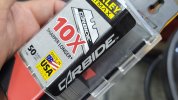Hickory n steel
Gold Member
- Joined
- Feb 11, 2016
- Messages
- 20,728
I don't know what the top one is in the second picture but it sure is a good looking spear point jack.You have to hunt a bit, but the stuff is out there. The G Sakai Trekker has a ZDP-189 main blade. The Terravantium Terrain 365 has a Dendritic Cobalt blade, and the LionSteel Roundhead has an M-390 blade. The MKM Malga 6 also has an M-390 blade. I enjoy my premium blades as much as I do the electric starter on my car.View attachment 1881095View attachment 1881093View attachment 1881094


